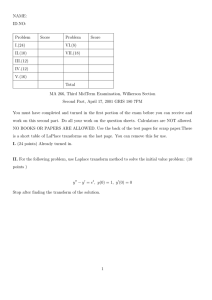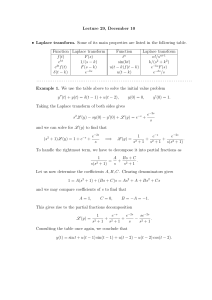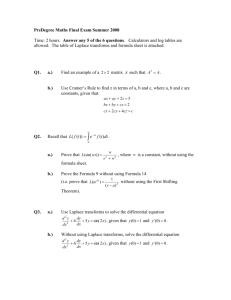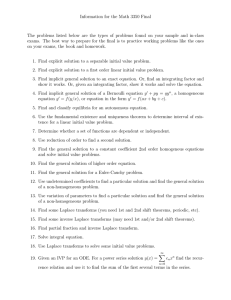Review Problems for Exam 2, Math 308-503, Fall 2014
advertisement
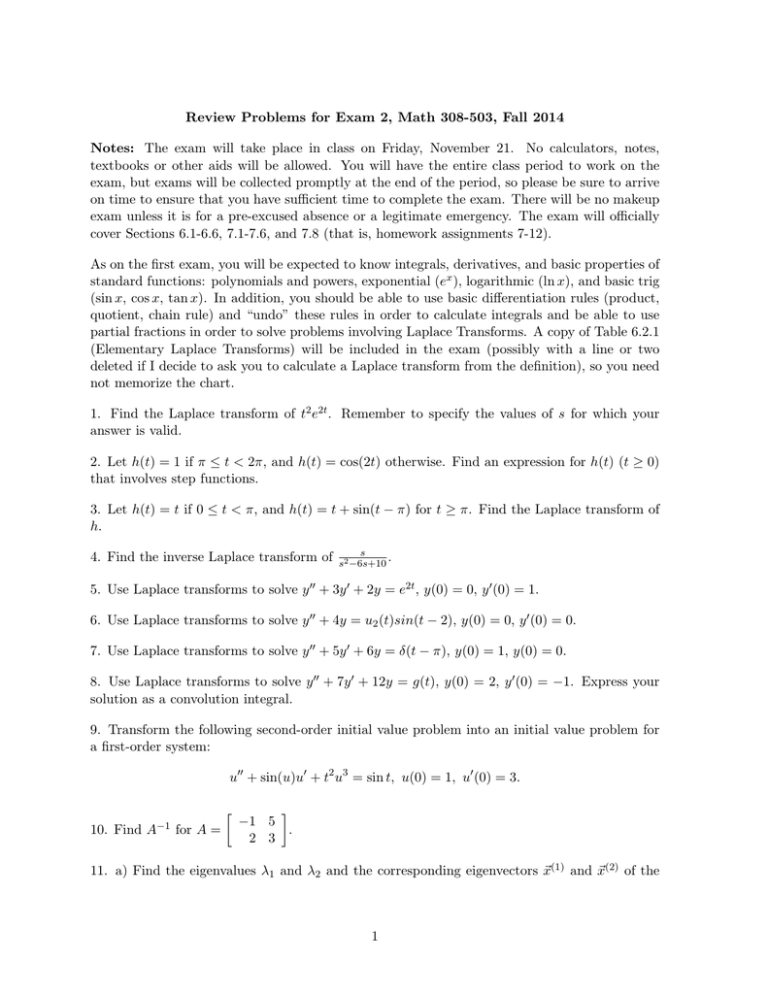
Review Problems for Exam 2, Math 308-503, Fall 2014 Notes: The exam will take place in class on Friday, November 21. No calculators, notes, textbooks or other aids will be allowed. You will have the entire class period to work on the exam, but exams will be collected promptly at the end of the period, so please be sure to arrive on time to ensure that you have sufficient time to complete the exam. There will be no makeup exam unless it is for a pre-excused absence or a legitimate emergency. The exam will officially cover Sections 6.1-6.6, 7.1-7.6, and 7.8 (that is, homework assignments 7-12). As on the first exam, you will be expected to know integrals, derivatives, and basic properties of standard functions: polynomials and powers, exponential (ex ), logarithmic (ln x), and basic trig (sin x, cos x, tan x). In addition, you should be able to use basic differentiation rules (product, quotient, chain rule) and “undo” these rules in order to calculate integrals and be able to use partial fractions in order to solve problems involving Laplace Transforms. A copy of Table 6.2.1 (Elementary Laplace Transforms) will be included in the exam (possibly with a line or two deleted if I decide to ask you to calculate a Laplace transform from the definition), so you need not memorize the chart. 1. Find the Laplace transform of t2 e2t . Remember to specify the values of s for which your answer is valid. 2. Let h(t) = 1 if π ≤ t < 2π, and h(t) = cos(2t) otherwise. Find an expression for h(t) (t ≥ 0) that involves step functions. 3. Let h(t) = t if 0 ≤ t < π, and h(t) = t + sin(t − π) for t ≥ π. Find the Laplace transform of h. 4. Find the inverse Laplace transform of s . s2 −6s+10 5. Use Laplace transforms to solve y 00 + 3y 0 + 2y = e2t , y(0) = 0, y 0 (0) = 1. 6. Use Laplace transforms to solve y 00 + 4y = u2 (t)sin(t − 2), y(0) = 0, y 0 (0) = 0. 7. Use Laplace transforms to solve y 00 + 5y 0 + 6y = δ(t − π), y(0) = 1, y(0) = 0. 8. Use Laplace transforms to solve y 00 + 7y 0 + 12y = g(t), y(0) = 2, y 0 (0) = −1. Express your solution as a convolution integral. 9. Transform the following second-order initial value problem into an initial value problem for a first-order system: u00 + sin(u)u0 + t2 u3 = sin t, u(0) = 1, u0 (0) = 3. 10. Find A−1 for A = −1 5 . 2 3 11. a) Find the eigenvalues λ1 and λ2 and the corresponding eigenvectors ~x(1) and ~x(2) of the 1 matrix A= −3 −5 3 4 1 . b) Show that the eigenvectors ~x(1) and ~x(2) from part a) are linearly independent. 3 t 1 (1) (2) 12. Let ~x (t) = and ~x (t) = . t2 t a) Compute the Wronskian of ~x(1) and ~x(2) . b) In what intervals are ~x(1) and ~x(2) linearly independent? p11 (t) p12 (t) c) Let P (t) = , and assume that ~x(1) and ~x(2) are both solutions of the system p21 (t) p22 (t) ~x0 (t) = P (t)~x(t). What conclusions can you draw about the matrix P (t)? 1 −2 are λ1 = −2 and λ2 = −1, and the corre13. The eigenvalues of the matrix A = 3 −4 1 2 . and ~x(2) = sponding eigenvectors are ~x(1) = 1 3 a) Find the general solution to the system ~x0 (t) = A~x. 0 in b) Draw a phase portrait for the above system and characterize the equilibrium point 0 terms of stability and type (node, spiral, etc.) 3 0 . c) Solve the initial value problem ~x (t) = A~x, ~x(0) = 4 5 −3 has a single eigenvalue λ = 2 with algebraic multiplicity 1. 14. The matrix A = 3 −1 a) Find all linearly independent eigenvectors of A. 0 b) Find the general solution to the system ~x (t) = A~x. 0 c) Characterize the equilibrium point in terms of stability and type (node, spiral, etc.) 0 −3 −7 15. Let A = . 1 −1 a) Find the eigenvalues and associated eigenvectors of A. 0 b) Find the general solution to the system ~x (t) = A~x. 0 c) Characterize the equilibrium point in terms of stability and type (node, spiral, etc.) 0 2

